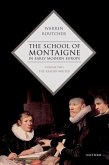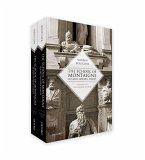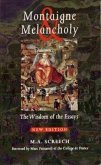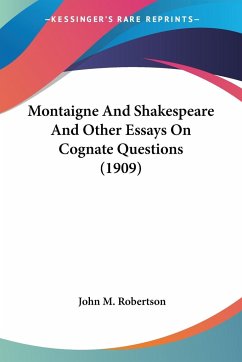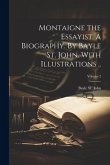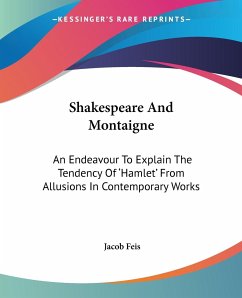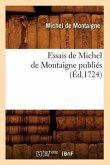- Broschiertes Buch
- Merkliste
- Auf die Merkliste
- Bewerten Bewerten
- Teilen
- Produkt teilen
- Produkterinnerung
- Produkterinnerung
- Weitere 7 Ausgaben:
- Gebundenes Buch
- Broschiertes Buch
- Broschiertes Buch
- eBook, ePUB
- eBook, ePUB
- eBook, PDF
- eBook, PDF
The first volume of a major two-volume study centres on the fortunes of Michel de Montaigne's Essays in both the early-modern (1580-1725) and the modern period (1900-2000). This volume examines how the Essays made Montaigne a patron-author or instant classic in the eyes of his peers.
Andere Kunden interessierten sich auch für
![The School of Montaigne in Early Modern Europe The School of Montaigne in Early Modern Europe]() Warren BoutcherThe School of Montaigne in Early Modern Europe48,99 €
Warren BoutcherThe School of Montaigne in Early Modern Europe48,99 €![The School of Montaigne in Early Modern Europe The School of Montaigne in Early Modern Europe]() Warren BoutcherThe School of Montaigne in Early Modern Europe293,99 €
Warren BoutcherThe School of Montaigne in Early Modern Europe293,99 €![Montaigne & Melancholy Montaigne & Melancholy]() M A ScreechMontaigne & Melancholy72,99 €
M A ScreechMontaigne & Melancholy72,99 €![Montaigne And Shakespeare And Other Essays On Cognate Questions (1909) Montaigne And Shakespeare And Other Essays On Cognate Questions (1909)]() John M. RobertsonMontaigne And Shakespeare And Other Essays On Cognate Questions (1909)36,99 €
John M. RobertsonMontaigne And Shakespeare And Other Essays On Cognate Questions (1909)36,99 €![Montaigne the Essayist. A Biography. By Bayle St. John. With Illustrations ..; Volume 2 Montaigne the Essayist. A Biography. By Bayle St. John. With Illustrations ..; Volume 2]() Bayle St JohnMontaigne the Essayist. A Biography. By Bayle St. John. With Illustrations ..; Volume 227,99 €
Bayle St JohnMontaigne the Essayist. A Biography. By Bayle St. John. With Illustrations ..; Volume 227,99 €![Shakespeare And Montaigne Shakespeare And Montaigne]() Jacob FeisShakespeare And Montaigne17,99 €
Jacob FeisShakespeare And Montaigne17,99 €![Essais de Michel de Montaigne Publiés (Éd.1724) Essais de Michel de Montaigne Publiés (Éd.1724)]() Michel De MontaigneEssais de Michel de Montaigne Publiés (Éd.1724)31,99 €
Michel De MontaigneEssais de Michel de Montaigne Publiés (Éd.1724)31,99 €-
-
-
The first volume of a major two-volume study centres on the fortunes of Michel de Montaigne's Essays in both the early-modern (1580-1725) and the modern period (1900-2000). This volume examines how the Essays made Montaigne a patron-author or instant classic in the eyes of his peers.
Hinweis: Dieser Artikel kann nur an eine deutsche Lieferadresse ausgeliefert werden.
Hinweis: Dieser Artikel kann nur an eine deutsche Lieferadresse ausgeliefert werden.
Produktdetails
- Produktdetails
- Verlag: Hurst & Co.
- Seitenzahl: 464
- Erscheinungstermin: 8. Dezember 2022
- Englisch
- Abmessung: 237mm x 157mm x 25mm
- Gewicht: 739g
- ISBN-13: 9780192867148
- ISBN-10: 0192867148
- Artikelnr.: 66144633
- Herstellerkennzeichnung
- Libri GmbH
- Europaallee 1
- 36244 Bad Hersfeld
- gpsr@libri.de
- Verlag: Hurst & Co.
- Seitenzahl: 464
- Erscheinungstermin: 8. Dezember 2022
- Englisch
- Abmessung: 237mm x 157mm x 25mm
- Gewicht: 739g
- ISBN-13: 9780192867148
- ISBN-10: 0192867148
- Artikelnr.: 66144633
- Herstellerkennzeichnung
- Libri GmbH
- Europaallee 1
- 36244 Bad Hersfeld
- gpsr@libri.de
Warren Boutcher is Professor of Renaissance Studies in the School of English and Drama, Faculty of Humanities and Social Sciences, Queen Mary University of London. He has published extensively on Montaigne and on humanism, translation, and the history of the book and of libraries in early modern England, France, and Italy.
Introduction
1.1 Prologue: Literature and agency in late medieval and early modern Europe
1.1.1: The force of the imagination
1.1.2: Montaigne's medallion as index
1.1.3: Art, agency, and the offices of self-knowledge
1.1.4: The qualities of a freeman
1.1.5: Reading-and-writing
1.1.6: Lady Anne Clifford
1.1.7: The book in the post-Reformation age
1.1.8: Acting and conversing through books
1.1.9: Imagines ingeniorum
1.1.10: Montaigne's imago
1.1.11: Pierre Eyquem's Sebond
1.1.12: Paratexts and the story of a book
1.1.13: Medallion and book
1.1.14: Van Ravesteyn's portrait of Pieter van Veen
1.1.15: Settings and situations
1.2 Villey and the making of the modern critical reader
1.2.1: This great reader
1.2.2: Villey's reception
1.2.3: Rival transcriptions of Montaigne's evolution
1.2.4: Strowski and Brunetiÿre
1.2.5: The distinctive evolution of Villey's Montaigne
1.2.6: Creating an oeuvre
1.3 The patron's oeuvre
1.3.1: Montaigne's self-portrait: Essais (1580) II 17 and II 18
1.3.2: The Journal de voyage
1.3.3: Urbino
1.3.4: The Journal and the Essais
1.3.5: Florence's patron
1.3.6: The place of books in the patron's oeuvre
1.3.7: Statues and books in Rome
1.3.8: Two works by patron-authors
1.3.9: Inauthentic patrons of books
1.3.10: Coda: the patron's book
1.4 Offices without names
1.4.1: London 1603
1.4.2: The desire for knowledge and the fall of man
1.4.3: Apology
1.4.4: Madame de Duras and the art of balneology
1.4.5: Offices without names in the Journal de voyage
1.5 The unpremeditated and accidental philosopher
1.5.1: Vettori and Montaigne on Tacitus
1.5.2: Extracting and applying literary curiosities
1.5.3: From ancient extracts to new pieces of man
1.5.4: Pierre de Lancre
1.5.5: Examining witches
1.5.6: On the lame (in Pierre Dheure's eyes)
1.5.7: The Montaigne effect
1.6 Caring for fortunes
1.6.1: 'La franchise de ma conversation'
1.6.2: Bienheureuse franchise
1.6.3: The French Thales
1.6.4: Gournay and Montaigneâs cold reception
1.6.5: Lipsius
1.6.6: Montaigne's missing letters
1.6.7: Pierre de Brachâs letters: Montaigne as 'patron'
1.6.8: Caring for fortunes
1.6.9: The genesis of the Essais
1.6.10: Amyot's Plutarch
1.6.11: The III 12 anecdotes
1.6.12: Essais I 23 (in 1580)
1.6.13: La BoÃ(c)tie
1.6.14: Pierre's Sebond and the liberty to judge
1.7 Montaigne at Rome, 1580-81: The Essais and the Papal court
1.7.1: Montaigne at Rome
1.7.2: 'Le Seneque de Rome'
1.7.3: Censoring the 1580 Essais
1.7.4: Roman topics in the Essais and the Journal
1.7.5: Rome's liberty
1.7.6: Montaigne's Roman citizenship
1.7.7: Essais III 9, 'De la vanitÃ(c)' (1588)
Conclusion
Bibliography
1.1 Prologue: Literature and agency in late medieval and early modern Europe
1.1.1: The force of the imagination
1.1.2: Montaigne's medallion as index
1.1.3: Art, agency, and the offices of self-knowledge
1.1.4: The qualities of a freeman
1.1.5: Reading-and-writing
1.1.6: Lady Anne Clifford
1.1.7: The book in the post-Reformation age
1.1.8: Acting and conversing through books
1.1.9: Imagines ingeniorum
1.1.10: Montaigne's imago
1.1.11: Pierre Eyquem's Sebond
1.1.12: Paratexts and the story of a book
1.1.13: Medallion and book
1.1.14: Van Ravesteyn's portrait of Pieter van Veen
1.1.15: Settings and situations
1.2 Villey and the making of the modern critical reader
1.2.1: This great reader
1.2.2: Villey's reception
1.2.3: Rival transcriptions of Montaigne's evolution
1.2.4: Strowski and Brunetiÿre
1.2.5: The distinctive evolution of Villey's Montaigne
1.2.6: Creating an oeuvre
1.3 The patron's oeuvre
1.3.1: Montaigne's self-portrait: Essais (1580) II 17 and II 18
1.3.2: The Journal de voyage
1.3.3: Urbino
1.3.4: The Journal and the Essais
1.3.5: Florence's patron
1.3.6: The place of books in the patron's oeuvre
1.3.7: Statues and books in Rome
1.3.8: Two works by patron-authors
1.3.9: Inauthentic patrons of books
1.3.10: Coda: the patron's book
1.4 Offices without names
1.4.1: London 1603
1.4.2: The desire for knowledge and the fall of man
1.4.3: Apology
1.4.4: Madame de Duras and the art of balneology
1.4.5: Offices without names in the Journal de voyage
1.5 The unpremeditated and accidental philosopher
1.5.1: Vettori and Montaigne on Tacitus
1.5.2: Extracting and applying literary curiosities
1.5.3: From ancient extracts to new pieces of man
1.5.4: Pierre de Lancre
1.5.5: Examining witches
1.5.6: On the lame (in Pierre Dheure's eyes)
1.5.7: The Montaigne effect
1.6 Caring for fortunes
1.6.1: 'La franchise de ma conversation'
1.6.2: Bienheureuse franchise
1.6.3: The French Thales
1.6.4: Gournay and Montaigneâs cold reception
1.6.5: Lipsius
1.6.6: Montaigne's missing letters
1.6.7: Pierre de Brachâs letters: Montaigne as 'patron'
1.6.8: Caring for fortunes
1.6.9: The genesis of the Essais
1.6.10: Amyot's Plutarch
1.6.11: The III 12 anecdotes
1.6.12: Essais I 23 (in 1580)
1.6.13: La BoÃ(c)tie
1.6.14: Pierre's Sebond and the liberty to judge
1.7 Montaigne at Rome, 1580-81: The Essais and the Papal court
1.7.1: Montaigne at Rome
1.7.2: 'Le Seneque de Rome'
1.7.3: Censoring the 1580 Essais
1.7.4: Roman topics in the Essais and the Journal
1.7.5: Rome's liberty
1.7.6: Montaigne's Roman citizenship
1.7.7: Essais III 9, 'De la vanitÃ(c)' (1588)
Conclusion
Bibliography
Introduction
1.1 Prologue: Literature and agency in late medieval and early modern Europe
1.1.1: The force of the imagination
1.1.2: Montaigne's medallion as index
1.1.3: Art, agency, and the offices of self-knowledge
1.1.4: The qualities of a freeman
1.1.5: Reading-and-writing
1.1.6: Lady Anne Clifford
1.1.7: The book in the post-Reformation age
1.1.8: Acting and conversing through books
1.1.9: Imagines ingeniorum
1.1.10: Montaigne's imago
1.1.11: Pierre Eyquem's Sebond
1.1.12: Paratexts and the story of a book
1.1.13: Medallion and book
1.1.14: Van Ravesteyn's portrait of Pieter van Veen
1.1.15: Settings and situations
1.2 Villey and the making of the modern critical reader
1.2.1: This great reader
1.2.2: Villey's reception
1.2.3: Rival transcriptions of Montaigne's evolution
1.2.4: Strowski and Brunetiÿre
1.2.5: The distinctive evolution of Villey's Montaigne
1.2.6: Creating an oeuvre
1.3 The patron's oeuvre
1.3.1: Montaigne's self-portrait: Essais (1580) II 17 and II 18
1.3.2: The Journal de voyage
1.3.3: Urbino
1.3.4: The Journal and the Essais
1.3.5: Florence's patron
1.3.6: The place of books in the patron's oeuvre
1.3.7: Statues and books in Rome
1.3.8: Two works by patron-authors
1.3.9: Inauthentic patrons of books
1.3.10: Coda: the patron's book
1.4 Offices without names
1.4.1: London 1603
1.4.2: The desire for knowledge and the fall of man
1.4.3: Apology
1.4.4: Madame de Duras and the art of balneology
1.4.5: Offices without names in the Journal de voyage
1.5 The unpremeditated and accidental philosopher
1.5.1: Vettori and Montaigne on Tacitus
1.5.2: Extracting and applying literary curiosities
1.5.3: From ancient extracts to new pieces of man
1.5.4: Pierre de Lancre
1.5.5: Examining witches
1.5.6: On the lame (in Pierre Dheure's eyes)
1.5.7: The Montaigne effect
1.6 Caring for fortunes
1.6.1: 'La franchise de ma conversation'
1.6.2: Bienheureuse franchise
1.6.3: The French Thales
1.6.4: Gournay and Montaigneâs cold reception
1.6.5: Lipsius
1.6.6: Montaigne's missing letters
1.6.7: Pierre de Brachâs letters: Montaigne as 'patron'
1.6.8: Caring for fortunes
1.6.9: The genesis of the Essais
1.6.10: Amyot's Plutarch
1.6.11: The III 12 anecdotes
1.6.12: Essais I 23 (in 1580)
1.6.13: La BoÃ(c)tie
1.6.14: Pierre's Sebond and the liberty to judge
1.7 Montaigne at Rome, 1580-81: The Essais and the Papal court
1.7.1: Montaigne at Rome
1.7.2: 'Le Seneque de Rome'
1.7.3: Censoring the 1580 Essais
1.7.4: Roman topics in the Essais and the Journal
1.7.5: Rome's liberty
1.7.6: Montaigne's Roman citizenship
1.7.7: Essais III 9, 'De la vanitÃ(c)' (1588)
Conclusion
Bibliography
1.1 Prologue: Literature and agency in late medieval and early modern Europe
1.1.1: The force of the imagination
1.1.2: Montaigne's medallion as index
1.1.3: Art, agency, and the offices of self-knowledge
1.1.4: The qualities of a freeman
1.1.5: Reading-and-writing
1.1.6: Lady Anne Clifford
1.1.7: The book in the post-Reformation age
1.1.8: Acting and conversing through books
1.1.9: Imagines ingeniorum
1.1.10: Montaigne's imago
1.1.11: Pierre Eyquem's Sebond
1.1.12: Paratexts and the story of a book
1.1.13: Medallion and book
1.1.14: Van Ravesteyn's portrait of Pieter van Veen
1.1.15: Settings and situations
1.2 Villey and the making of the modern critical reader
1.2.1: This great reader
1.2.2: Villey's reception
1.2.3: Rival transcriptions of Montaigne's evolution
1.2.4: Strowski and Brunetiÿre
1.2.5: The distinctive evolution of Villey's Montaigne
1.2.6: Creating an oeuvre
1.3 The patron's oeuvre
1.3.1: Montaigne's self-portrait: Essais (1580) II 17 and II 18
1.3.2: The Journal de voyage
1.3.3: Urbino
1.3.4: The Journal and the Essais
1.3.5: Florence's patron
1.3.6: The place of books in the patron's oeuvre
1.3.7: Statues and books in Rome
1.3.8: Two works by patron-authors
1.3.9: Inauthentic patrons of books
1.3.10: Coda: the patron's book
1.4 Offices without names
1.4.1: London 1603
1.4.2: The desire for knowledge and the fall of man
1.4.3: Apology
1.4.4: Madame de Duras and the art of balneology
1.4.5: Offices without names in the Journal de voyage
1.5 The unpremeditated and accidental philosopher
1.5.1: Vettori and Montaigne on Tacitus
1.5.2: Extracting and applying literary curiosities
1.5.3: From ancient extracts to new pieces of man
1.5.4: Pierre de Lancre
1.5.5: Examining witches
1.5.6: On the lame (in Pierre Dheure's eyes)
1.5.7: The Montaigne effect
1.6 Caring for fortunes
1.6.1: 'La franchise de ma conversation'
1.6.2: Bienheureuse franchise
1.6.3: The French Thales
1.6.4: Gournay and Montaigneâs cold reception
1.6.5: Lipsius
1.6.6: Montaigne's missing letters
1.6.7: Pierre de Brachâs letters: Montaigne as 'patron'
1.6.8: Caring for fortunes
1.6.9: The genesis of the Essais
1.6.10: Amyot's Plutarch
1.6.11: The III 12 anecdotes
1.6.12: Essais I 23 (in 1580)
1.6.13: La BoÃ(c)tie
1.6.14: Pierre's Sebond and the liberty to judge
1.7 Montaigne at Rome, 1580-81: The Essais and the Papal court
1.7.1: Montaigne at Rome
1.7.2: 'Le Seneque de Rome'
1.7.3: Censoring the 1580 Essais
1.7.4: Roman topics in the Essais and the Journal
1.7.5: Rome's liberty
1.7.6: Montaigne's Roman citizenship
1.7.7: Essais III 9, 'De la vanitÃ(c)' (1588)
Conclusion
Bibliography


